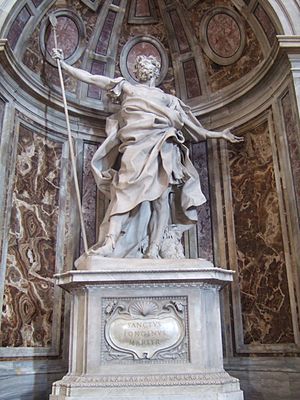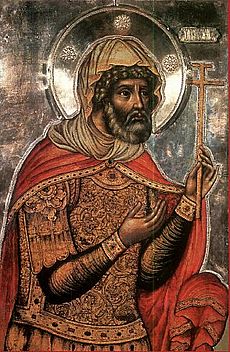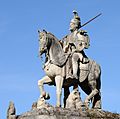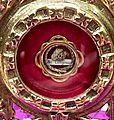Longinus facts for kids
Quick facts for kids SaintLonginus |
|
|---|---|

Statue of Saint Longinus by Bernini in Saint Peter's Basilica
|
|
| Born | 1st century in Sandiale or Sandrales of Cappadocia |
| Died | 1st century |
| Venerated in | Anglican Communion Coptic Orthodox Church Eastern Orthodox Church Oriental Orthodoxy Catholic Church |
| Major shrine | Inside St. Peter's Basilica, Vatican City |
| Feast |
|
| Attributes | Military attire, lance |
Longinus (/lɒnˈdʒaɪnəs/) is the name given to the unnamed Roman soldier who pierced the side of Jesus with a lance; who in medieval and some modern Christian traditions is described as a convert to Christianity. His name first appeared in the apocryphal Gospel of Nicodemus. The lance is called in Christianity the "Holy Lance" (lancea) and the story is related in the Gospel of John during the Crucifixion. This act is said to have created the last of the Five Holy Wounds of Christ.
This person, unnamed in the Gospels, is further identified in some versions of the legend as the centurion present at the Crucifixion, who said that Jesus was the son of God, so he is considered as one of the first Christians and Roman converts. Longinus' legend grew over the years to the point that he was said to have converted to Christianity after the Crucifixion, and he is traditionally venerated as a saint in the Roman Catholic Church, Eastern Orthodox Church, and several other Christian communions.
Contents
Origins of the story
No name for this soldier is given in the canonical Gospels; the name Longinus is instead found in the apocryphal Gospel of Nicodemus. Longinus was not original a saint in Christian tradition. An early tradition, found in a sixth or seventh century pseudepigraphal "Letter of Herod to Pilate", claims that Longinus suffered for having pierced Jesus, and that he was condemned to a cave where every night a lion came and mauled him until dawn, after which his body healed back to normal, in a pattern that would repeat until the end of time. Later traditions turned him into a Christian convert, but as Sabine Baring-Gould observed: "The name of Longinus was not known to the Greeks previous to the patriarch Germanus, in 715. It was introduced amongst the Westerns from the Apocryphal Gospel of Nicodemus. There is no reliable authority for the Acts and martyrdom of this saint."
The name is probably Latinized from the Greek lonche (λόγχη), the word used for the lance mentioned in John KJV. It first appears lettered on an illumination of the Crucifixion beside the figure of the soldier holding a spear, written, perhaps contemporaneously, in horizontal Greek letters, LOGINOS (ΛΟΓΙΝΟϹ), in the Syriac gospel manuscript illuminated by a certain Rabulas in the year 586, in the Laurentian Library, Florence. The spear used is known as the Holy Lance, and more recently, especially in occult circles, as the "Spear of Destiny", which was revered at Jerusalem by the sixth century, although neither the centurion nor the name "Longinus" were invoked in any surviving report. As the "Lance of Longinus", the spear figures in the legends of the Holy Grail.
Blindness or other eye problems are not mentioned until after the tenth century. Petrus Comestor was one of the first to add an eyesight problem to the legend and his text can be translated as "blind", "dim-sighted" or "weak-sighted". The Golden Legend says that he saw celestial signs before conversion and that his eye problems might have been caused by illness or age.
The body of Longinus is said to have been lost twice, and that its second recovery was at Mantua in 1304, together with the Holy Sponge stained with Christ's blood, wherewith it was told—extending Longinus' role—that Longinus had assisted in cleansing Christ's body when it was taken down from the cross. The relic, corpules of alleged blood taken from the Holy Lance, enjoyed a revived cult in late 13th century Bologna under the combined impetus of the Grail romances, the local tradition of eucharistic miracles, the chapel consecrated to Longinus, the Holy Blood in the Benedictine monastery church of Sant'Andrea, and the patronage of the Bonacolsi.
The relics are said to have been divided and then distributed to Prague and elsewhere, with the body taken to the Basilica of Sant'Agostino in Rome. However, official guides of the Basilica do not mention the presence of any tomb associated with Saint Longinus. It is also said that the body of Longinus was found in Sardinia; Greek sources assert that he suffered martyrdom in Gabala, Cappadocia.
Present-day veneration
Longinus is venerated, generally as a martyr, in the Roman Catholic Church, the Eastern Orthodox Church, and the Armenian Apostolic Church. His feast day is kept on 16 October in the Roman Martyrology, which mentions him, without any indication of martyrdom, in the following terms: "At Jerusalem, commemoration of Saint Longinus, who is venerated as the soldier opening the side of the crucified Lord with a lance". The pre-1969 feast day in the Roman Rite is 15 March. The Eastern Orthodox Church commemorates him on 16 October. In the Armenian Apostolic Church, his feast is commemorated on 22 October.
The statue of Saint Longinus, sculpted by Gian Lorenzo Bernini, is one of four in the niches beneath the dome of Saint Peter's Basilica, Vatican City. A spearpoint fragment said to be from the Holy Lance is also conserved in the Basilica.
Longinus and his legend are the subject of the Moriones Festival held during Holy Week on the island of Marinduque, the Philippines.
Brazil
Folkloric role
Under the folk name "São Longuinho", Saint Longinus is attributed the power of finding missing objects. The saint's aid is summoned by the chant:
São Longuinho, São Longuinho, se eu achar [missing object], dou três pulinhos!
(São Longuinho, São Longuinho, if I find [missing object], I'll hop three times!)
Folk tradition explains the association with missing objects with a tale from the saint's days in Rome. It is said he was of short stature and, as such, had unimpeded view of the underside of tables in crowded parties. Due to this, he would find and return objects dropped on the ground by the other attendants.
Accounts vary regarding the promised offering of three hops, citing either deference to an alleged limping of the saint or a plea to the Holy Trinity.
Brazilian spiritism
Brazilian medium Chico Xavier wrote Brasil, Coração do Mundo, Pátria do Evangelho, a psychographic book of authorship attributed to the spirit of Humberto de Campos. In the book, Saint Longinus is claimed to have been reincarnated as Pedro II, the last Brazilian emperor.
Gallery
See also
 In Spanish: Longinos (centurión) para niños
In Spanish: Longinos (centurión) para niños
- List of names for the Biblical nameless
- Moriones Festival
- Wandering Jew, a figure with whom he is sometimes identified








